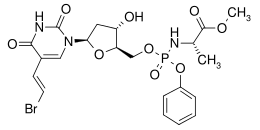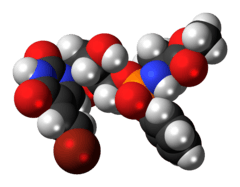Thymectacin
 | |
 | |
| Identifiers | |
|---|---|
| |
| CAS Number | |
| PubChem CID | |
| ChemSpider | |
| Chemical and physical data | |
| Formula | C21H25BrN3O9P |
| Molar mass | 574.3185 g/mol |
| 3D model (JSmol) | |
| |
| |
| | |
Thymectacin (NB-1011, NB-101, N-[[5-[(E)-2-Bromovinyl]-2'-deoxyuridin-5'-O-yl]](phenoxy)phosphoryl]-L-alanine methyl ester) is an anticancer prodrug of brivudine monophosphate. It developed by New Biotics and it has entered in phase I clinical trials for colon cancer.[1]
References
- ↑ Wilson, R. H. (2006). "Novel Therapeutic Developments Other Than EGFR and VEGF Inhibition in Colorectal Cancer". The Oncologist. 11 (9): 1018–1024. doi:10.1634/theoncologist.11-9-1018. PMID 17030644.
Description of Thymectacin: Thymectacin, also known as NB-1011, is a small molecule phosphoramidate derivative of (E)-5-(2-bromovinyl)-2'-deoxyuridine with potential antineoplastic activity. Selectively active against tumor cells expressing high levels of thymidylate synthase (TS), BVdU pronucleotide analogue NB1011 is converted intracellularly by TS to bromovinyldeoxyuridine monophosphate (BVdUMP) which competes with the natural substrate, deoxyuridine monophosphate, for binding to TS. Unlike TS inhibitors, this agent is a reversible substrate for TS catalysis. Thus, TS retains activity and converts BVdUMP into cytotoxic metabolites.